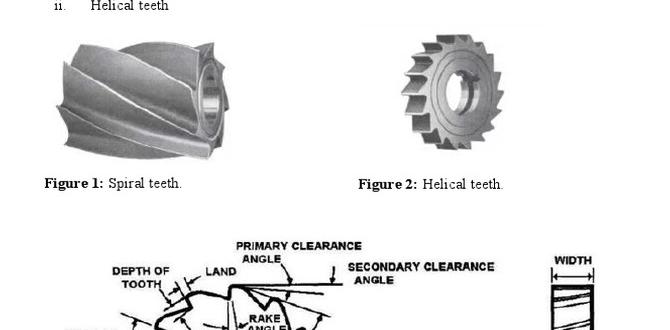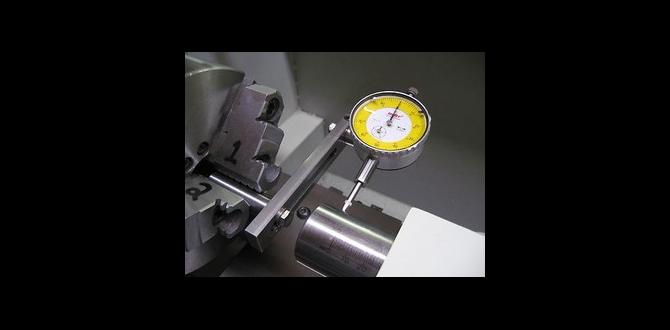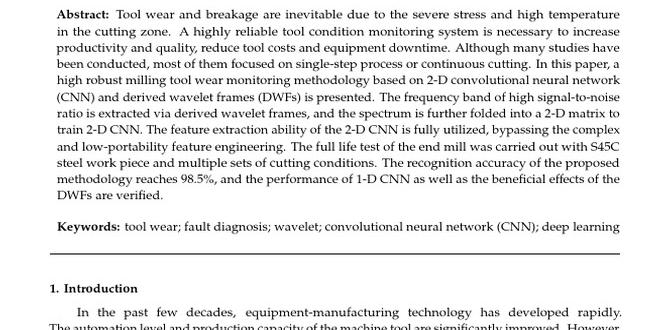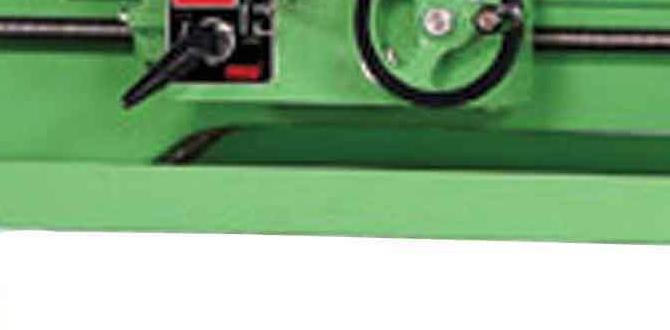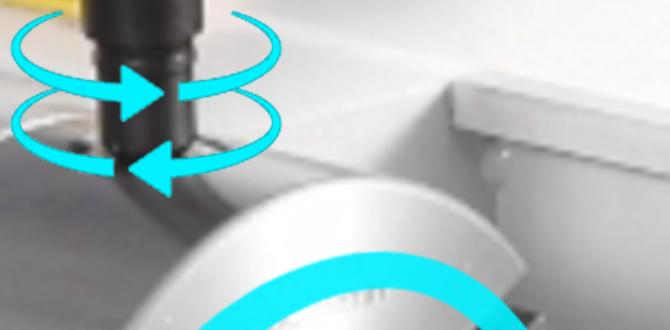Quick Summary: Investing in dust collection for your lathe is crucial for a cleaner, safer, and healthier workspace. It effectively removes airborne particles, protects your machine, and improves workpiece visibility, making your machining tasks more enjoyable and productive.
Working with a lathe, whether it’s for metal or wood, creates dust and chips. This debris can quickly fill up your workshop, making it hard to see what you’re doing and even posing health risks. But don’t worry, setting up a good dust collection system for your lathe is simpler than you might think! At Lathe Hub, we’re all about making machining accessible, and today we’re going to walk you through exactly why and how to get your lathe workspace dust-free. Get ready to breathe easier and machine with more confidence.
Why Lathe Dust Collection is Your Essential Power-Up
As a machinist for many years, I’ve seen firsthand how much of a mess a lathe can make. Wood shavings fly, metal chips scatter, and fine dust gets everywhere. It’s not just about keeping your shop tidy; it’s about safety, machine longevity, and the quality of your work. Think of dust collection not as an optional extra, but as an essential upgrade for your lathe.
Health and Air Quality: Breathing Easy While You Work
The most important reason to have dust collection for your lathe is your health. The fine particles, especially from wood or certain metals, can be harmful when inhaled. Small wood dust particles can irritate your lungs and lead to long-term respiratory problems, such as asthma or bronchitis. Metal dust, particularly from certain alloys, can contain heavy metals that are toxic.
According to the Occupational Safety and Health Administration (OSHA), controlling airborne contaminants is a fundamental workplace safety requirement. This applies just as much to a home workshop as it does to a professional setting. A good dust collection system acts as your first line of defense, capturing these particles right at the source before they can become airborne and enter your lungs.
Machine Longevity: Protecting Your Investment
Dust and chips aren’t just irritating; they’re abrasive. When they settle on your lathe’s ways, lead screws, motors, and electronics, they can cause wear and tear over time. Metal chips can get into crucial moving parts, leading to increased friction, reduced accuracy, and premature failure of components. Wood dust, especially if it’s fine and sticky, can clog motor vents and cause overheating. By removing this abrasive material, you’re significantly extending the life of your lathe and keeping it running smoothly for years to come.
Improved Visibility and Work Quality: See What You’re Doing
Imagine trying to make a precise cut when your workpiece and the area around it are obscured by flying dust and chips. It’s difficult, frustrating, and increases the likelihood of mistakes. A dust collection system, especially one with good airflow directed at the cutting point, can dramatically improve visibility. This means you can see your tool engage the material, monitor chip formation, and make accurate adjustments in real-time. Better visibility leads to cleaner cuts, more accurate dimensions, and a higher quality finished product. It also makes your entire machining process far more enjoyable.
Shop Cleanliness: Keeping Your Workspace Tidy
Let’s be honest, nobody likes cleaning up a huge mess after a project. Dust and chips from a lathe can easily spread throughout a workshop, settling on benches, floors, and other tools. A dust collection system captures the majority of this waste at the source, making cleanup significantly easier and faster. A cleaner workshop is also a safer workshop, reducing trip hazards and the chance of debris getting into other machinery.
Understanding the Key Components of Lathe Dust Collection
A dust collection system can seem complicated, but it’s usually made up of a few core components that work together. Knowing what each part does will help you choose and set up the right system for your lathe.
1. The Dust Collector/Vacuum Unit
This is the heart of the system. It’s a powerful motor that creates suction to pull air and debris through your ducting. There are a few types you might encounter:
Shop Vacuums: Many DIYers start with a good quality shop vacuum. They are versatile and readily available. For dust collection, look for one with a strong CFM (Cubic Feet per Minute) rating, which indicates airflow. Many also have HEPA filters, which are great for fine dust.
Single-Stage Dust Collectors: These are dedicated units designed for dust collection. They typically have a motor that spins an impeller, creating suction. The dust is often collected in a separate bin. They are more powerful than most shop vacuums.
Two-Stage Dust Collectors: These are more advanced. They use a cyclone separator to spin the dust and chips out of the airstream before it reaches the filter and fan. This keeps the filter much cleaner, maintaining suction power and extending filter life. They are generally the most effective but also the most expensive.
2. Ducting: The Airways of Your System
Ducting is the network of pipes or hoses that carry the dust from your lathe to the collector.
Hoses: Flexible hoses are common, especially for connecting directly to the lathe. Look for smooth interiors to prevent dust buildup and kinks. The diameter of the hose is important; too small and it restricts airflow, too large and the suction might not be strong enough to move heavier chips. Common sizes are 2.5″, 4″, or larger.
Pipes: Rigid PVC or metal pipes are excellent for longer runs or for creating a fixed system in your workshop. They offer less resistance to airflow than flexible hoses.
Fittings and Adapters: You’ll need elbows, wyes, and adapters to connect different sections of ducting and to hook up to dust ports on your lathe or dust shoes.
Table: Dust Collector Specifications to Consider
| Specification | Importance for Lathe Dust Collection | What to Look For |
| :———— | :———————————– | :————— |
| CFM (Cubic Feet per Minute) | High: Higher CFM means stronger suction and better chip/dust removal. Crucial for efficient collection. | Aim for at least 300-500 CFM for a single machine like a lathe. Larger CFM is usually better. |
| Static Pressure (SP) / Sealed Inches of Water (SIW) | High: Measures the collector’s ability to overcome resistance in the ducting and filters. Essential for maintaining airflow over distance. | A higher number indicates better ability to pull air through the system. Needs to be matched to your ducting length and filter type. |
| Amperage / Horsepower (HP) | Medium: Generally correlates with CFM and SP, but CFM/SP are more direct measures of performance. | Higher HP motors often provide higher CFM/SP, but don’t solely rely on this metric. |
| Filtration Efficiency (Microns) | High: Determines how well the system captures fine particles. Critical for health benefits. | Look for filters rated to capture 1-micron or smaller particles. HEPA filters are excellent. |
| Noise Level (Decibels – dB) | Medium: Important for comfort, especially in a home workshop. | Lower dB ratings mean a quieter operation. Some collectors have silencers. |
3. Dust Ports and Collection Hoods/Shoes
This is where the magic happens – at the point of dust generation.
Lathe Dust Ports: Some lathes come with integrated dust collection ports. If yours doesn’t, you might need to adapt.
Dust Shoes: These are custom-made or purchased attachments fitted around the cutting tool area. They are designed to create a seal or a close fit to the workpiece, maximizing the amount of dust and chips captured directly by the suction. For wood lathes, a shoe that can move with the cross-slide or tool rest is ideal. For metal lathes, it might be a shroud around the cutting tool.
Shrouds: These are enclosures that surround the workpiece or the cutting area to effectively contain dust and chips.
Setting Up Your Lathe Dust Collection System: A Step-by-Step Guide
Getting your dust collection system up and running is a rewarding process. Here’s how to approach it, assuming you’re starting with a shop vac or a basic single-stage collector and flexible hose – a common setup for beginners.
Step 1: Choose Your Dust Collector
Evaluate your needs and budget.
For occasional light woodworking: A good shop vac (1.5 HP or higher, with good CFM) might suffice. Ensure it has a collection bag or canister that can handle wood dust, and ideally a fine dust filter.
For regular woodworking or light metalworking: A dedicated single-stage 1-2 HP dust collector is a good investment. Make sure it has a filter capable of handling fine dust.
For heavy use or fine metal dust concerns: Consider a two-stage collector with excellent filtration.
For this guide, we’ll assume you have a dust collector with a 2.5-inch or 4-inch port and a flexible hose. Check resources like Wood Magazine’s dust collection guides for further insights.
Step 2: Prepare Your Lathe
Inspect your lathe for any existing dust ports. If there are none, you’ll need to create a way to attach your dust collection hose.
Wood Lathes: Often, you can attach a hose near the tailstock or tool rest area. Some woodworkers create a simple shroud that clamps to the tool rest, with a port for the dust hose.
Metal Lathes: For metal lathes, the dust – or rather, chips – are usually generated at the cutting tool. You might need to fashion a small shroud around the tool post or over the cutting area on the workpiece. This is a more advanced setup and might require some fabrication.
Step 3: Connect the Ducting
This is where you create the pathway.
1. Attach Hose to Collector: Securely connect one end of your flexible hose to the dust collector’s outlet port. Use a hose clamp to ensure a tight seal.
2. Route the Hose: Run the hose from the collector to your lathe. Keep the run as short and straight as possible to maximize airflow. Avoid sharp bends or kinks in the hose, as these restrict airflow and can trap debris. Use zip ties or clamps to secure the hose along its run, preventing it from snagging on the lathe or workbench.
3. Connect to Lathe/Shrouds: Attach the other end of the hose to your lathe’s dust port or to your custom-made shroud/shoe. Again, a tight seal is crucial. If you’re using a shop vac, you might need an adapter to connect your hose to the vacuum’s inlet.
Step 4: Create or Attach a Dust Shoe/Shroud (Highly Recommended)
This is arguably the most critical part for effective collection at the point of generation.
For Wood Turning: Many commercially available dust collection attach ments fit onto tool rests. Alternatively, you can make a simple one using thin plywood or even thick plastic. Cut a hole for your dust hose and shape it to come as close as possible to the turning workpiece without rubbing. A common design is a curved hood that fits over the tool rest.
For Metal Turning: This is trickier. Fine metal dust is dangerous and requires excellent collection. A small shroud that can be clamped or attached near the cutting tool might be necessary. It needs to be positioned to catch chips as they are produced. Consider using strong magnets to hold a metal shroud in place. If you’re turning aluminum or brass, the chips can curl and fly; if you’re turning steel, they’re sharp. The South Bend Lathe Blog often has great examples of shop-made solutions.
Step 5: Test and Adjust
Turn on your dust collector.
Listen for Air Leaks: Ensure all connections are sealed. You should feel strong suction at the dust shoe/shroud.
Observe Collection: Make a test cut. Does the dust and chips get pulled away effectively?
Adjust Shoe/Shroud: You’ll likely need to fine-tune the position of your dust shoe or shroud to get the best collection. For wood turning, ensure it’s close to the work but doesn’t interfere with the tool. For metal, ensure it’s directly in the path of the chips.
Advanced Dust Collection Strategies for Lathes
Once you’ve got a basic system running, you might want to look into ways to improve its performance or adapt it to different lathe types.
Using a Cyclone Separator
As mentioned, a two-stage system uses a cyclone separator. This is a cone-shaped device that spins the incoming air/dust mixture. Heavier particles (chips and dust) are slung to the outside and fall into a collection bin below, while cleaner air goes through to the filter and fan.
Benefits: Dramatically increases filter life, maintains consistent suction power, and reduces the frequency of emptying the collector. Ideal for high-volume dust producers like lathes.
DIY Options: Many hobbyists build their own cyclone separators using two 55-gallon drums or plastic bins. A popular design is the Bill Pentz cyclone.
Improving Filtration
The standard filter on many shop vacs or basic collectors might not capture the finest, most harmful dust particles.
HEPA Filters: High-Efficiency Particulate Air (HEPA) filters capture at least 99.97% of airborne particles 0.3 microns in size. Using a HEPA filter on your dust collector or shop vac is a significant upgrade for health protection.
After-Filters: Some systems use a separate “after-filter” positioned after the main bag or canister to catch any fine dust that may escape.
Shop-Made Dust Booths and Hoods
For wood lathes, a fully enclosed dust booth can be very effective. This is essentially an enclosure around the lathe with a dust collection port integrated into the walls or ceiling. This helps contain all the dust. For metal lathes, a sturdy, magnetically attached shroud that can sweep across the bed with the carriage can be highly effective.
Resources: Forums like Practical Machinist’s woodworking section or specific lathe forums are excellent places to find ideas and plans for shop-made dust collection solutions.
Static Electricity and Metal Chips
Metal chips can carry a static charge, which can make them cling to surfaces or even give a mild shock. While less common than with fine dust, it’s something to be aware of, especially in dry workshop conditions. Using grounded ducting (metal pipes or grounded flexible hoses) can help dissipate static charges.
Lathe Dust Collection vs. Shop Sweep-Up: A Comparison
Many beginners initially rely on sweeping or using a regular vacuum after turning. Let’s compare that to a proper dust collection system.
| Feature | Regular Broom & Dust Pan | Standard Vacuum Cleaner | Lathe Dust Collection System |
| :—————— | :———————– | :———————- | :————————— |
| Dust Capture | Poor – kicks up fine dust | Moderate – better than broom, but still disperses fine dust | Excellent – captures at source |
| Health Impact | High risk – disperses fine dust | Moderate risk – still releases fine dust | Low risk – minimizes airborne particles |
| Machine Protection | Minimal – dust settles on ways | Minimal – dust can get into motor | High – prevents abrasive debris |
| Visibility | Poor – dust billows | Fair – slight improvement | Excellent – keeps area clear |
| Time/Effort | High – frequent sweeping | Moderate – requires vacuuming | Low – system collects during operation |
| Cost (Initial) | Very Low | Low to Moderate | Moderate to High |
| Cost (Ongoing) | Negligible | Bag/filter replacement | Bag/filter replacement, electricity |
As you can see, while a broom or regular vacuum might seem like a solution, a dedicated dust collection system for your lathe offers far superior benefits across the board.
FAQs: Your Lathe Dust Collection Questions Answered
Here are some common questions beginners have about dust collection for their lathes.
Q1: Can I just use my shop vacuum?
A1: A shop vacuum is a good starting point, especially for occasional use or lighter dust. However, it might not have enough CFM for effective collection on more demanding tasks, and its filters might not capture the finest, most harmful particles. It’s better than nothing, but a dedicated dust collector is more efficient.
Q2: What size hose do I need for my lathe dust collection?
A2: For most hobbyist wood lathes, a 2.5-inch or 4-inch diameter hose is suitable. Use the largest diameter hose that your dust collector port and dust shoe can accommodate without sacrificing too much suction velocity. Smoother interior hoses are always preferred.
Q3: How close should my dust shoe be to the workpiece?
A3: The closer the dust shoe or shroud is to the point of dust generation, the more effective it will be. Aim for a gap of about 1/4 inch to 1/2 inch, but ensure it doesn’t interfere with your cutting tool or the workpiece’s rotation for wood lathes.
Q4: Do I need dust collection for metal lathes?
A4: Absolutely. While it’s often called “chip collection” for metal lathes, the principle is the same. Metal chips are abrasive and can damage your machine. Also, fine metal dust can be a health hazard. Effective chip collection is vital for both safety and machine longevity.
* Q5: What’s the difference between a single

